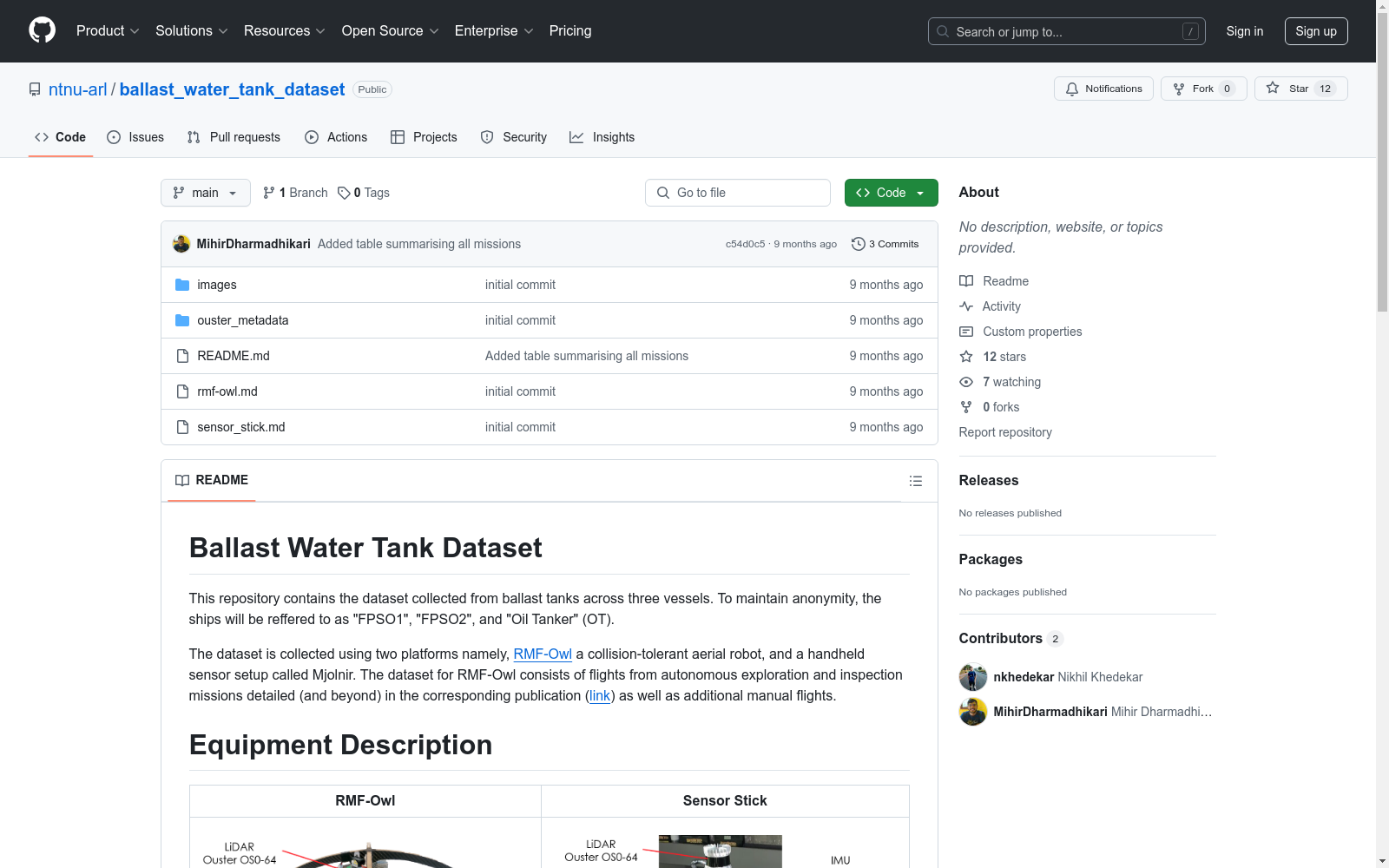Ballast Water Tank Dataset|船舶检查数据集|无人机监测数据集
收藏数据集概述
数据集名称
Ballast Water Tank Dataset
数据集来源
数据集来源于三艘船的压载水舱,分别标记为“FPSO1”, “FPSO2”, 和 “Oil Tanker” (OT)。
数据收集平台
- RMF-Owl: 一种碰撞容忍的空中机器人。
- Mjolnir: 手持传感器设置。
传感器配置
| 传感器 | RMF-Owl | Mjolnir (Sensor Stick) |
|---|---|---|
| LiDAR | Ouster OS0-64 (Rev-D) | Ouster OS0-64 (Rev-D) |
| Camera | Flir Blackfly S 0.4MP Color | Flir Blackfly S 0.4MP Mono (x2) |
| IMU | Vectornav VN100 | Vectornav VN100 |
| Radar | - | Texas Instruments IWR6843AOP-EVM Radar |
任务概览
RMF-Owl
| No. | Ship | Section | Autonomous | Multi-level | Duration (s) |
|---|---|---|---|---|---|
| 1 | FPSO1 | side | Yes | No | 225 |
| 2 | FPSO1 | side | Yes | No | 300 |
| 3 | FPSO1 | side | Yes | No | 154 |
| 4 | FPSO1 | side | No | Yes | 450 |
| 5 | FPSO2 | side | Yes | No | 300 |
| 6 | FPSO2 | side | Yes | No | 380 |
| 7 | FPSO2 | bilge | Yes | No | 336 |
| 8 | FPSO2 | double bottom | Yes | No | 200 |
| 9 | FPSO2 | side | No | Yes | 258 |
| 10 | FPSO2 | bilge, double bottom | No | No | 275 |
| 11 | OT | side | Yes | No | 214 |
| 12 | OT | side | Yes | No | 216 |
| 13 | OT | side | Yes | No | 354 |
| 14 | OT | side | Yes | No | 360 |
| 15 | OT | side | Yes | No | 370 |
Mjolnir
| No. | Ship | Section | Autonomous | Multi-level | Duration (s) |
|---|---|---|---|---|---|
| 1 | FPSO1 | side | N/A | No | 268 |
| 2 | FPSO1 | side | N/A | No | 373 |
| 3 | FPSO1 | side | N/A | No | 357 |
| 4 | FPSO1 | side | N/A | No | 395 |
数据隐私
为保护隐私,图像中的人脸已被模糊处理。

My Sexy Neighbor 🔞 Prologue Review Stats and Historical Trends
The My Sexy Neighbor 🔞 Prologue Steam review dataset lets you explore review stats, trends, and history for My Sexy Neighbor 🔞 Prologue reviews on Steam. Data is aggregated month over month going back to November 2024.
steambase.io 收录
中国区域交通网络数据集
该数据集包含中国各区域的交通网络信息,包括道路、铁路、航空和水路等多种交通方式的网络结构和连接关系。数据集详细记录了各交通节点的位置、交通线路的类型、长度、容量以及相关的交通流量信息。
data.stats.gov.cn 收录
China Health and Nutrition Survey (CHNS)
China Health and Nutrition Survey(CHNS)是一项由美国北卡罗来纳大学人口中心与中国疾病预防控制中心营养与健康所合作开展的长期开放性队列研究项目,旨在评估国家和地方政府的健康、营养与家庭计划政策对人群健康和营养状况的影响,以及社会经济转型对居民健康行为和健康结果的作用。该调查覆盖中国15个省份和直辖市的约7200户家庭、超过30000名个体,采用多阶段随机抽样方法,收集了家庭、个体以及社区层面的详细数据,包括饮食、健康、经济和社会因素等信息。自2011年起,CHNS不断扩展,新增多个城市和省份,并持续完善纵向数据链接,为研究中国社会经济变化与健康营养的动态关系提供了重要的数据支持。
www.cpc.unc.edu 收录
PASCAL VOC 2007
这个挑战的目标是从现实场景中的许多视觉对象类别中识别对象(即不是预先分割的对象)。它基本上是一个监督学习问题,因为它提供了一组标记图像的训练集。已选择的 20 个对象类别是: 人:人 动物:鸟、猫、牛、狗、马、羊 交通工具:飞机、自行车、船、公共汽车、汽车、摩托车、火车 室内:瓶子、椅子、餐桌、盆栽、沙发、电视/显示器 将有两个主要比赛和两个较小规模的“品酒师”比赛。内容:提供的训练数据由一组图像组成;每个图像都有一个注释文件,为图像中存在的 20 个类别之一中的每个对象提供一个边界框和对象类别标签。请注意,来自多个类的多个对象可能出现在同一图像中。
OpenDataLab 收录
遵义市2024年市本级一般公共预算收入预算表(草案)
遵义市2024年市本级一般公共预算收入预算表(草案)
贵州省政府数据开放平台 收录
